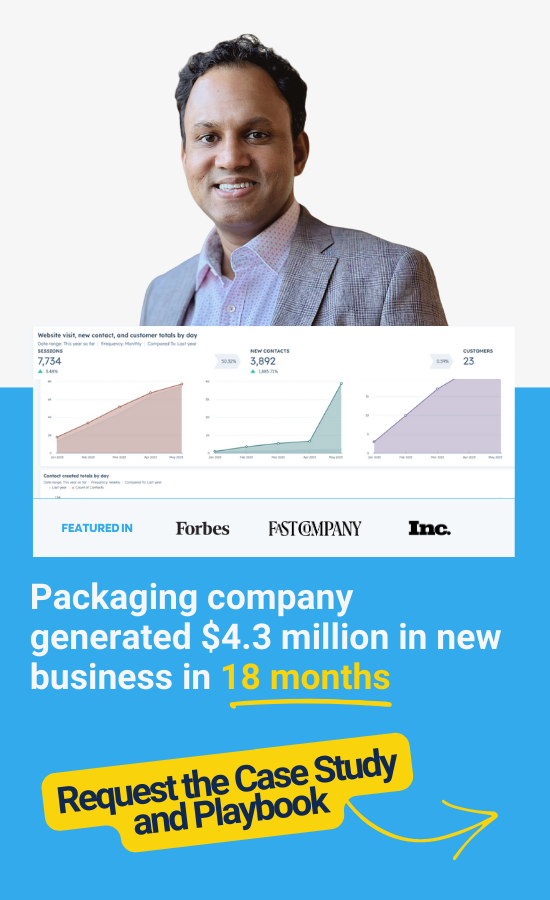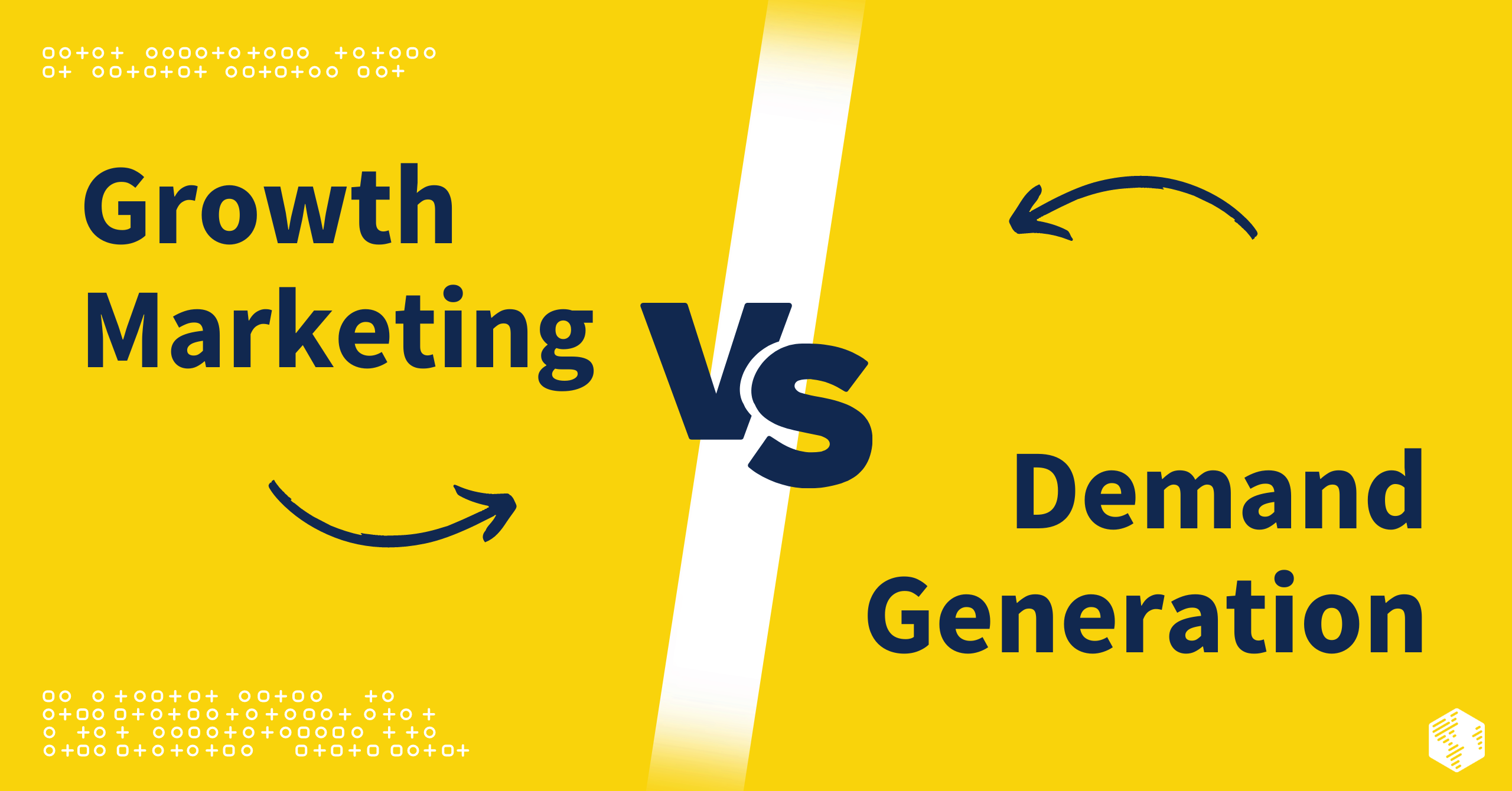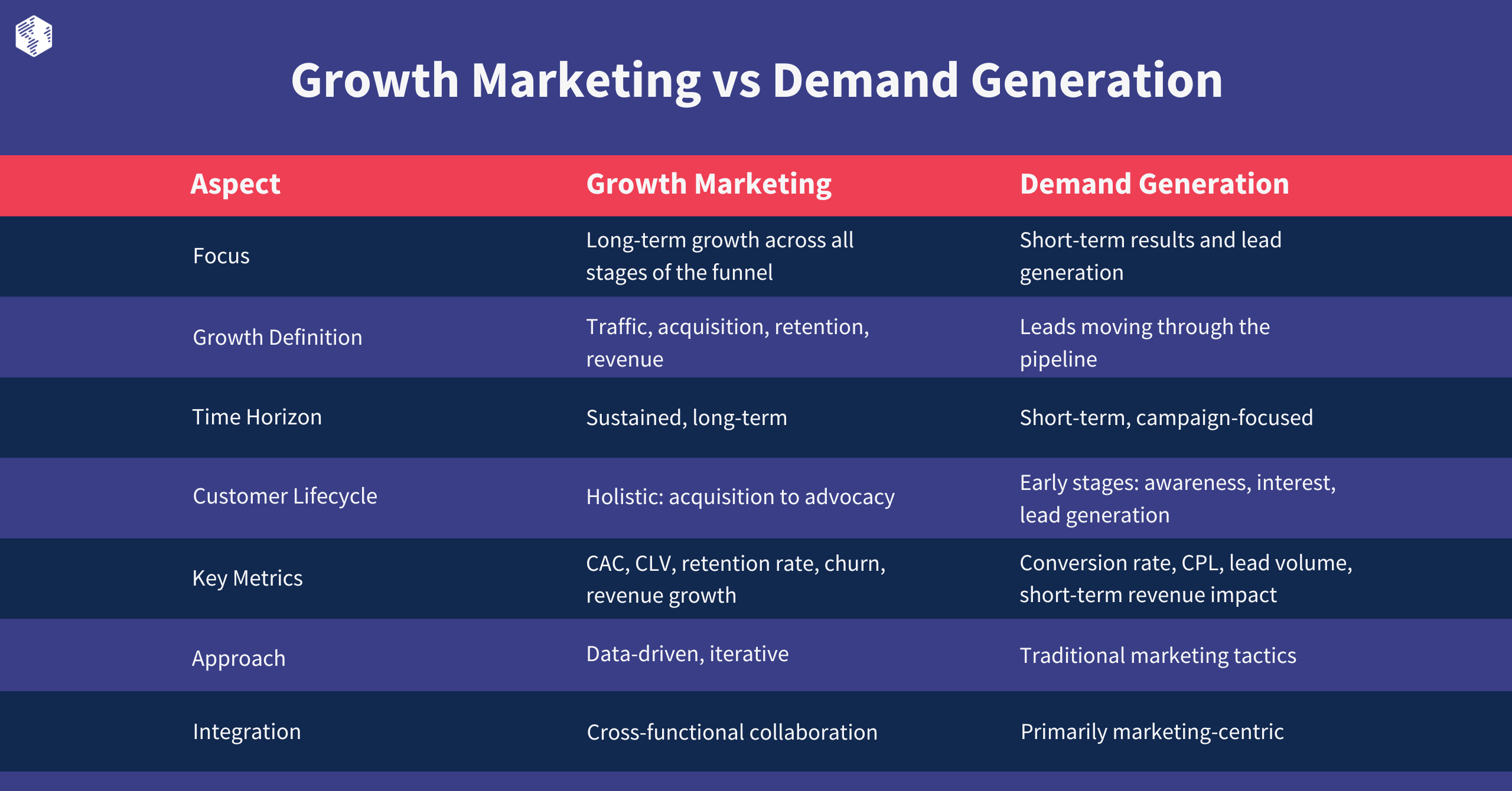The terms “growth marketing” and “demand generation” are often used interchangeably in the business-to-business (B2B) marketing space. What’s the difference between these two approaches, and which one is best for sustainable growth?
Let’s take a closer look at these two strategies, including the key differences between the two and how they can work together to help your organization achieve your revenue and growth goals.
What Is Growth Marketing?
Growth marketing is a strategic approach to marketing that relies on data analysis to identify growth opportunities and develop marketing strategies across channels that take advantage of those opportunities.
It encompasses a variety of tactics, including referral marketing, growth hacking, and email marketing, to build deeper, lifelong relationships with customers before and after the point of sale.
The goal of growth marketing is to achieve sustainable growth by attracting new business as well as retaining existing customers—in other words, growth marketing capitalizes on both sides of the bow tie funnel—because focusing on retention as well as acquisition is the key to increased revenue and long-term, predictable growth.
What Is Demand Generation?
Demand generation is a data-driven marketing approach that focuses on generating demand for your company’s products or services. The goal of demand generation is to drive interest in your brand, generate and nurture qualified leads, and move those leads through the sales pipeline.
As opposed to lead generation, which is a subset of demand generation that refers to the collection of contact information from potential leads, demand generation uses tactics such as content marketing and event marketing to find in-market buyers and achieve growth by converting them into customers.
Growth Marketing vs. Demand Generation: 7 Key Differences
Both growth marketing and demand generation contribute to revenue growth and the visibility of your B2B brand, but these terms are not interchangeable. Here are a few key differences between these two approaches to business growth.
Focus
The primary focus of growth marketing is on the long-term growth and expansion of your business. It aims to identify and leverage growth opportunities across different channels and throughout all stages of the bow tie funnel (both acquisition and retention).
Demand generation is focused on short-term results, primarily generating leads and driving immediate sales to meet specific revenue targets. While it explores more of the customer lifecycle than lead generation, which is limited to the first steps of the customer lifecycle, demand generation targets the acquisition side (left side) of the bow tie funnel.
Growth
Since growth marketing is a comprehensive approach to revenue growth, it involves many different types of growth, including traffic, customer acquisition and retention rates, and overall revenue. Improvements in any of these areas may be a sign of growth marketing success.
However, demand generation has a more limited definition of growth. It is primarily concerned with leads moving through the pipeline, and therefore any demand generation initiatives that do not lead to increased leads or conversions may not be considered successful.
Time Horizon
Growth marketing is more concerned with sustained growth over an extended period. It involves ongoing experiences, optimizations, and continuous improvements that lead to sustainable, long-term growth.
Demand generation is typically more short-term oriented, often tied to specific marketing campaigns and sales cycles.
Customer Lifecycle
Growth marketing takes a holistic approach. It considers the entire customer lifecycle, from acquisition to conversion, retention, and advocacy. It emphasizes the importance of providing value at each stage to drive customer loyalty and referrals.
Demand generation usually focuses on the early stages of the customer lifecycle, such as creating awareness and interest and generating leads.
Metrics
Key metrics in growth marketing include customer acquisition cost (CAC), customer lifetime value (CLV or LTV), retention rate, churn rate, and overall revenue growth. These metrics look at the big-picture growth of a B2B organization across a variety of business goals and key performance indicators (KPIs).
As demand generation is usually most concerned with results from its part of the pipeline, key metrics include lead conversion rate, cost per lead (CPL), lead generation volume, and short-term revenue impact.
Approach
Growth marketing relies on a data-driven and iterative approach where marketers continuously test and optimize various strategies to achieve growth. When tactics result in increased revenue and positive metrics, you can devote more resources to those campaigns or channels. Alternatively, initiatives that do not lead to growth can be adjusted or eliminated.
Demand generation often involves more traditional marketing tactics like advertising, content marketing, events, and direct sales outreach to drive immediate demand. These initiatives drum up immediate interest and encourage prospects to enter the sales pipeline, (hopefully) leading to a revenue boost.
Integration
Growth marketing involves cross-functional collaboration, integrating marketing efforts with product development, customer support, and other departments to create a seamless customer experience. Combined with a revenue operations (RevOps) framework, growth marketing optimizes growth across the entire customer lifecycle and requires input from all customer-facing teams (marketing, sales, customer success).
Demand generation is primarily marketing-centric and may not involve the same level of integration with other business functions as growth marketing does. However, your marketing operations (MarketingOps) team can monitor your demand generation initiatives, analyze the results, and determine the most effective way to integrate the approach into your existing marketing strategy.
READ: What is Demand Generation and Why is it Important for Your B2B Business?
Is Growth Marketing or Demand Generation Better for B2B Companies?
When it comes down to it, which approach is better for B2B companies: growth marketing or demand generation?
The answer may (not) surprise you: They aren’t mutually exclusive! Your organization can combine both demand generation and growth marketing methodologies to create a holistic marketing strategy that optimizes revenue growth across the entire customer lifecycle. Folding in demand generation as part of a larger growth marketing strategy is the best way to target your ideal customers, transform existing customers into brand ambassadors, and bring reliable growth to your brand.
Partner with OneIMS to Grow Your Business
The secret to achieving long-term, sustainable growth is taking a holistic approach. By investing in demand generation for short-term progress as part of a larger growth marketing framework, you can acquire new buyers and retain existing customers throughout the customer lifecycle (and beyond).
At OneIMS, our approach to growth is defined by our growth formula framework. We use our proven formula as a guide that works hand in hand with the bow tie funnel, demand generation tactics, and an overall growth marketing strategy to support your revenue goals.
We have a history of working with companies in a variety of industries to achieve sustainable growth, and we pride ourselves on producing measurable and sustainable results. But you don’t have to take our word for it: View testimonials from our clients and read our blog to get an idea of our training, experience, and track record of success.
Are you ready to reach new customers, build ongoing relationships with existing buyers, find new revenue opportunities, and grow your business? Schedule a consultation with us today to get started.



































